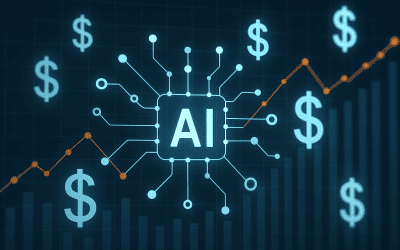The world of AI and machine learning continues to evolve at an unprecedented pace. From customized enterprise generative AI models to the growing emphasis on AI ethics and security risks, there are several trends that are set to shape the future of this transformative technology.
Imagine a world where AI-driven systems can tailor customized solutions to specific business needs. Companies are increasingly leveraging generative AI models to create innovative solutions across various industries, revolutionizing how we work and interact.
However, the success of these advanced systems relies on something equally important: talent. The past year has witnessed a significant shift in the demand for skilled professionals who can implement and optimize AI and machine learning technologies. It’s not just about the algorithms; it’s about the people behind them.
Moreover, as AI becomes more prevalent in our daily lives, the need for robust ethics and security measures has never been more critical. With high-profile incidents highlighting the potential vulnerabilities of AI systems, there is an increasing focus on developing clear guidelines and regulations to ensure responsible and secure AI usage.
In this blog, we will dive into the top 10 AI and machine learning trends for 2024, exploring the latest advancements, their impact on businesses, and the challenges they present. Whether you’re a technology enthusiast or a business leader seeking to stay ahead of the curve, this blog will provide you with valuable insights and actionable takeaways to navigate the ever-evolving landscape of AI and machine learning. Get ready to uncover the future of AI and machine learning!
Multimodal AI: Expanding the Horizons of AI Technology
Multimodal AI is a cutting-edge approach that combines multiple modes of sensory information, such as images, text, and audio, to enable more comprehensive and nuanced understanding by artificial intelligence systems. By expanding the horizons of AI technology, multimodal AI opens up exciting possibilities for various industries.
Real-World Applications
Multimodal AI has the potential to revolutionize industries like healthcare, autonomous vehicles, and customer service. In healthcare, multimodal AI can analyze and interpret medical images, patient records, and clinical data simultaneously, leading to more accurate diagnoses and treatment plans. Autonomous vehicles can benefit from multimodal AI by integrating visual, auditory, and sensor data to enhance safety and decision-making capabilities.
In customer service, multimodal AI can analyze customer interactions across different channels, including text and voice, to provide personalized and seamless experiences. For example, virtual assistants equipped with multimodal AI can understand user queries better and respond appropriately with relevant information.
Enhancing AI Capabilities
Multimodal AI enables AI systems to process and understand a wide range of data types, enhancing their abilities to recognize patterns, uncover insights, and make accurate predictions. For instance, a multimodal AI model can generate detailed and contextually rich descriptions of images by combining visual cues with textual information.
Furthermore, multimodal AI can enable machines to understand and interpret human emotions, gestures, and intentions. This capability opens up possibilities for more intuitive human-machine interactions and personalized experiences.
Impact on Industries
The impact of multimodal AI on various industries is substantial. It can lead to more precise diagnostics, improved patient outcomes, and streamlined operations in the healthcare industry. In transportation, it can advance the development of autonomous vehicles, making them safer and more efficient.
In the entertainment sector, multimodal AI can enhance virtual and augmented reality experiences by integrating audio, visual, and haptic feedback. This immersive integration can provide users with a more realistic and engaging environment.
Unlocking the Future Potential
The potential of multimodal AI is vast, and its continuous advancement holds promise for future innovative applications. As technology progresses, multimodal AI models will become more sophisticated, capable of understanding and analyzing a broader range of data types, including video and gestural inputs.
Researchers and developers are actively exploring the potential of multimodal AI to revolutionize communication systems, education, and even personal robotics. By leveraging the power of multimodal AI, we can unlock new realms of possibilities and achieve greater technological breakthroughs.
Agentic AI: Empowering AI agents with proactive capabilities
Agentic AI is a groundbreaking development in the field of artificial intelligence that is revolutionizing how AI agents interact with and respond to their environment. Unlike traditional AI systems that primarily rely on pre-programmed rules and instructions, agentic AI empowers AI agents with proactive capabilities, enabling them to solve problems and make decisions in a more autonomous and independent manner.
With agentic AI, AI agents are no longer confined to a reactive role, simply responding to inputs and commands. Instead, they can actively seek out information, analyze data, and take proactive actions to achieve desired outcomes. This shift towards proactive AI has the potential to greatly enhance the capabilities and effectiveness of AI agents across various industries and domains.
Key Advantages Of Agentic AI
One of the key advantages of agentic AI is the ability of AI agents to learn and adapt to evolving situations. By continuously learning from their interactions and experiences, AI agents can refine their decision-making processes and improve their problem-solving abilities over time. This adaptability allows AI agents to navigate complex and dynamic environments more efficiently and accurately.
Agentic AI also enables AI agents to generate alternative solutions and explore different possibilities. This means that AI agents have the freedom to explore uncharted territories and propose creative solutions that might not have been explicitly programmed. By thinking beyond pre-defined rules and limitations, agentic AI opens up new avenues for innovation and breakthroughs in problem-solving.
Furthermore, agentic AI can enhance human-AI collaboration by providing more intuitive and natural interactions. Instead of relying solely on explicit commands, agentic AI agents can anticipate human needs and take proactive steps to assist and support users. This seamless integration of AI technology into human workflows can significantly enhance productivity and efficiency in various domains.
However, it is important to note that agentic AI also raises ethical considerations. As AI agents become more autonomous and proactive, it is crucial to ensure that they operate within ethical boundaries and align with societal values. Responsible development and deployment of agentic AI systems require careful consideration of transparency, accountability, and fairness.
Open Source AI: Leveraging The Power Of Collaborative Development
Open-source AI models have emerged as a powerful resource, revolutionizing the field of artificial intelligence. The significance of open-source AI lies in its collaborative development approach, which allows developers and researchers to share their work openly, fostering innovation and customization. By leveraging the power of collective knowledge and expertise, open-source AI models offer a range of advantages that make them a preferred choice in many applications.
Advantages Of Open-Source AI Models
1. Customization and adaptability: Open-source AI models allow developers to customize and fine-tune algorithms according to specific use cases. This level of adaptability enables businesses to tailor AI models to their unique requirements, improving accuracy and performance.
2. Innovation and community support: The open-source AI community is a vibrant ecosystem of developers, researchers, and enthusiasts who continually contribute to the improvement of AI models. This collaborative environment fosters innovation, ensuring models stay updated with the latest advancements.
3. Transparency and Auditability: Open-source AI models offer transparency, allowing developers to inspect and understand the underlying algorithms. This transparency ensures that AI systems are accountable, auditable, and free from biases, addressing concerns related to ethical AI development.
4. Cost-effective implementation: Open-source AI models provide a cost-effective alternative to proprietary solutions. Organizations can leverage and build upon existing open-source models, reducing development time and expenses associated with creating AI systems from scratch.
Examples Of Successful Open-Source AI Projects
1. OpenAI’s GPT-4 model: GPT-4 is an open-source language model that has gained much attention in the tech world. Its large-scale neural network architecture enables it to generate human-like text, making it a valuable tool for various applications, including content generation and language translation.
2. Stanford’s Human-Centered AI Institute: This research institute focuses on developing open-source AI tools that are ethically responsible and human-centric. Their initiatives aim to address the societal impacts of AI and ensure its alignment with human values.
Retrieval-augmented Generation: Bridging The Gap Between Generations
Advancements in artificial intelligence (AI) and machine learning are revolutionizing how content is generated. One such innovation is retrieval-augmented generation, a technique combining retrieval-based methods with generative models to bridge the gap between existing knowledge and new content creation. In this section, we will explore the concept of retrieval-augmented generation in AI and its potential to transform how we generate high-quality content.
What is retrieval-augmented generation?
Retrieval-augmented generation involves leveraging pre-existing knowledge through retrieval-based methods and integrating it with the capabilities of generative models. This approach allows AI systems to access a vast amount of existing information and use it to generate new and valuable content. By combining the strengths of both retrieval and generation, retrieval-augmented generation represents a significant advancement in natural language processing.
Generating High-Quality Content Based On Existing Knowledge
Retrieval-augmented generation generates high-quality content by leveraging the information available in existing datasets. The AI system can retrieve relevant and accurate information from various sources, including articles, books, and research papers. This retrieved knowledge is then used to augment the generative capabilities of the model, resulting in the production of coherent and contextually relevant content.
Applications In Various Domains
Retrieval-augmented generation has vast applications across content creation, chatbots, virtual assistants, and customer support systems. Using existing knowledge, AI systems equipped with retrieval-augmented generation can provide accurate and informative responses to user queries, streamline customer interactions, and assist in content generation tasks.
Improving Efficiency And Accuracy
One of the key benefits of retrieval-augmented generation is its ability to improve the efficiency and accuracy of content generation. By leveraging existing knowledge, the AI system can quickly access relevant information, reducing the time and effort required to generate comprehensive and well-informed content. This approach eliminates the need for lengthy training on large datasets and allows for more efficient content-creation processes.
Ethical Considerations
While retrieval-augmented generation offers significant potential, ethical considerations must be addressed. The reliance on existing data and pre-existing knowledge raises concerns about bias and inaccuracies in the generated content. It is crucial to implement robust mechanisms to mitigate these issues and ensure that retrieved information is reliable and unbiased.
Customized enterprise generative AI models: Tailoring AI for specific business needs
Customized generative AI models are becoming increasingly valuable for businesses as they offer a highly tailored solution to address specific needs and use cases. By leveraging the power of AI technology, organizations can optimize processes, improve decision-making, and enhance customer experiences. This section will explore the importance of customized enterprise generative AI models and how they can be harnessed to drive innovation and success.
The Significance Of Customization
One-size-fits-all AI solutions may not always align perfectly with the unique requirements of businesses. However, with customized generative AI models, companies can tailor the technology to suit their needs. This level of customization enables organizations to extract maximum value from the AI system and achieve desired outcomes.
Addressing Specific Use Cases
Generative AI models can be fine-tuned to address specific use cases across various industries. Whether it’s generating personalized product recommendations for e-commerce platforms, automating data analysis for financial institutions, or optimizing supply chain management for logistics companies, customized generative AI models can be trained to meet the specific demands of each business.
Improving Efficiency And Accuracy
Customized AI models allow businesses to automate and streamline complex processes, improving operational efficiency. These models can quickly analyze vast amounts of data and provide accurate insights, eliminating the need for manual efforts and minimizing the chance of human error. As a result, organizations can make more informed decisions and drive better outcomes.
Enhancing Customer Experiences
The ability to tailor AI models to meet specific business needs can greatly enhance customer experiences. By utilizing generative AI, organizations can develop personalized recommendations, offer targeted marketing campaigns, and provide highly relevant and engaging content. This level of customization helps businesses connect with their customers on a deeper level, increasing customer satisfaction and loyalty.
Need For AI and Machine Learning Talent: Meeting The Growing Demand
With the rapid advancements in AI and machine learning technologies, the demand for skilled professionals in these fields is growing exponentially. Organizations across various industries are realizing the potential of AI and the competitive advantage it can provide. As a result, there is a pressing need to attract and retain talent with expertise in AI and machine learning.
The Rising Demand For AI and Machine Learning Professionals
The past few years have witnessed a significant shift in the business landscape, with AI and machine learning becoming integral to various business operations. From healthcare and finance to manufacturing and retail, organizations leverage AI to streamline processes, enhance decision-making, and drive innovation. This widespread adoption has led to a surge in demand for professionals who can develop, deploy, and manage AI-powered systems.
Steps Organizations Can Take To Attract And Retain Talent
Organizations must adopt strategies that attract top professionals and create an environment conducive to their growth and development to meet the growing demand for AI and machine learning talent. Some key steps organizations can take:
1. Offer competitive compensation: Providing competitive salaries and benefits packages is crucial to attracting skilled AI professionals. Organizations must stay updated on industry standards and research market rates to ensure they are offering attractive compensation packages.
2. Invest in continuous learning opportunities: AI and machine learning rapidly evolve, and professionals must stay updated with the latest advancements. Training programs, workshops, and certifications can help attract talent and demonstrate the organization’s commitment to employee growth.
3. Foster a collaborative and innovative culture: Creating a culture encouraging collaboration, experimentation, and innovation can attract top talent eager to work on cutting-edge projects. Promote cross-functional collaboration and provide access to resources that support innovation.
4. Develop a strong employer brand: Establishing a strong employer brand can make organizations more attractive to AI and machine learning professionals. Highlight the organization’s commitment to diversity, inclusion, and ethical AI practices to attract talent that aligns with the organization’s values.
5. Provide opportunities for meaningful work: To attract and retain top AI and machine learning professionals, organizations should offer challenging and meaningful projects. Providing autonomy and the opportunity to work on impactful projects can be a strong motivation for talent to join and stay with an organization.
Meeting the growing demand for AI and machine learning talent requires organizations to take proactive steps to attract, retain, and nurture skilled professionals. By offering competitive compensation, investing in continuous learning opportunities, fostering a collaborative culture, developing a strong employer brand, and providing meaningful work, organizations can position themselves as employers of choice in the AI and machine learning space.








